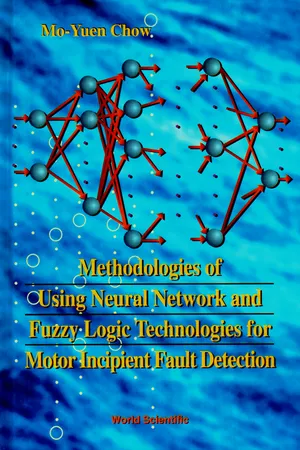
Methodologies Of Using Neural Network And Fuzzy Logic Technologies For Motor Incipient Fault Detection
- 160 pages
- English
- PDF
- Available on iOS & Android
Methodologies Of Using Neural Network And Fuzzy Logic Technologies For Motor Incipient Fault Detection
About this book
Motor monitoring, incipient fault detection, and diagnosis are important and difficult topics in the engineering field. These topics deal with motors ranging from small DC motors used in intensive care units to the huge motors used in nuclear power plants. With proper machine monitoring and fault detection schemes, improved safety and reliability can be achieved for different engineering system operations. The importance of incipient fault detection can be found in the cost saving which can be obtained by detecting potential machine failures before they occur. Non-invasive, inexpensive, and reliable fault detection techniques are often preferred by many engineers. A large number of techniques, such as expert system approaches and vibration analysis, have been developed for motor fault detection purposes. Those techniques have achieved a certain degree of success. However, due to the complexity and importance of the systems, there is a need to further improve existing fault detection techniques.A major key to the success in fault detection is the ability to use appropriate technology to effectively fuse the relevant information to provide accurate and reliable results. The advance in technology will provide opportunities for improving existing fault detection schemes. With the maturing technology of artificial neural network and fuzzy logic, the motor fault detection problem can be solved using an innovative approach based on measurements that are easily accessible, without the need for rigorous mathematical models. This approach can identify and aggregate the relevant information for accurate and reliable motor fault detection. This book will introduce the neccessary concepts of neural network and fuzzy logic, describe the advantages and challenges of using these technologies to solve motor fault detection problems, and discuss several design considerations and methodologies in applying these techniques to motor incipient fault detection.
Frequently asked questions
- Essential is ideal for learners and professionals who enjoy exploring a wide range of subjects. Access the Essential Library with 800,000+ trusted titles and best-sellers across business, personal growth, and the humanities. Includes unlimited reading time and Standard Read Aloud voice.
- Complete: Perfect for advanced learners and researchers needing full, unrestricted access. Unlock 1.4M+ books across hundreds of subjects, including academic and specialized titles. The Complete Plan also includes advanced features like Premium Read Aloud and Research Assistant.
Please note we cannot support devices running on iOS 13 and Android 7 or earlier. Learn more about using the app.
Information
Table of contents
- CONTENTS
- PREFACE
- ACKNOWLEDGEMENT
- CHAPTER 1 INTRODUCTION TO MOTOR INCIPIENT FAULT DETECTION
- CHAPTER 2 INTRODUCTION TO ARTIFICIAL NEURAL NETWORKS
- CHAPTER 3 INTRODUCTION TO FUZZY LOGIC
- CHAPTER 4 FAST PROTOTYPE MOTOR SYSTEM SIMULATION
- CHAPTER 5 DESIGN AND TRAINING OF FEEDFORWARD NEURAL NETWORKS FOR MOTOR FAULT DETECTION
- CHAPTER 6 ROBUSTNESS CONSIDERATION OF MOTOR FAULT DETECTION NEURAL NETWORKS
- CHAPTER 7 FUZZY LOGIC APPROACH FOR CONFIGURING A MOTOR FAULT DETECTION NEURAL NETWORK
- CHAPTER 8 APPLICATION OF NEURAL/FUZZY SYSTEM FOR MOTOR FAULT DETECTION
- CONCLUDING REMARKS
- INDEX